Welcome to the enchanting world of California’s sand dunes, where the magic of the desert meets adventure like nowhere else.
Depart on a journey to explore the best sand dunes in the Golden State. This article includes locations, sizes, must-know tips, permit requirements, visitor restrictions, and the ideal times to experience the majesty of these natural wonders.
What Makes a Sand Dune?
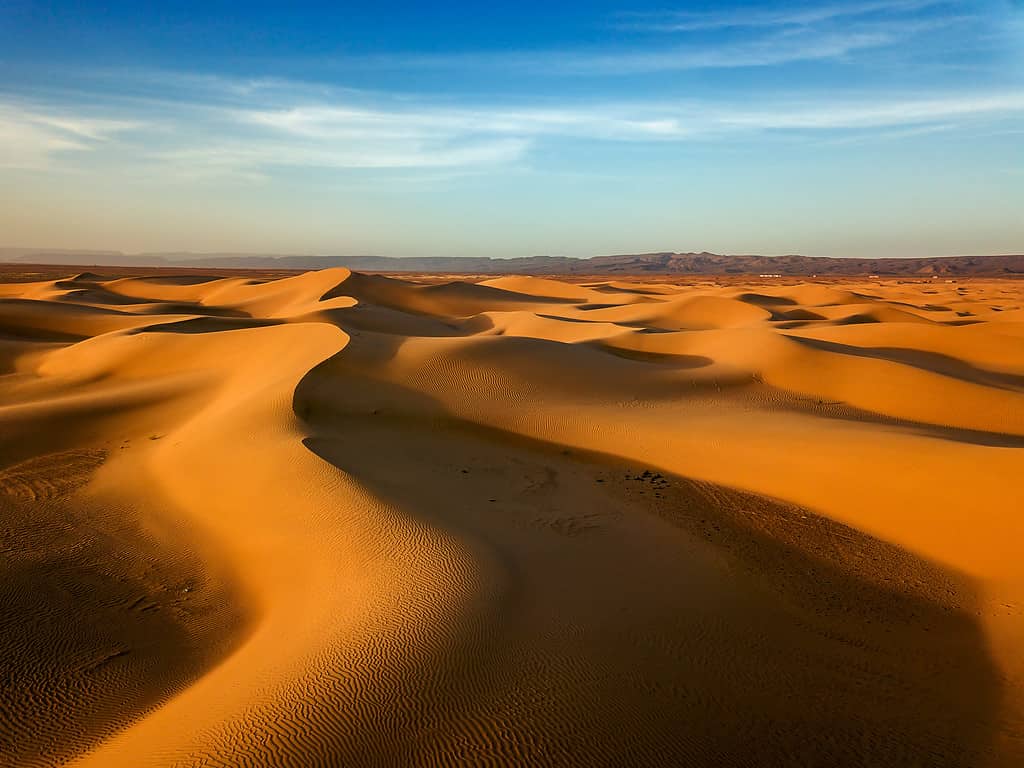
Sand dunes are natural landforms created by the accumulation of wind-blown sand.
©Mik122/iStock via Getty Images
Sand dunes are natural landforms created by the accumulation of wind-blown sand. Several factors contribute to the formation of sand dunes:
Wind
Wind is the primary agent responsible for shaping sand dunes. It carries sand grains from one place and deposits them in another, gradually building up dunes over time.
Sand Supply
A continuous supply of sand is essential for dune formation. This often comes from sandy beaches, riverbanks, or deserts where there is an abundance of loose sand particles.
Obstacles
In some cases, obstacles such as rocks, vegetation, or buildings can obstruct the flow of wind-blown sand. When the wind encounters these obstacles, it slows down, depositing the sand it was carrying and forming dunes behind these barriers.
Vegetation
Certain types of vegetation, such as dune grasses, can play a crucial role in stabilizing sand dunes. Their root systems help anchor the sand, preventing it from being easily blown away by the wind.
Topography
The local topography of an area can influence the formation of sand dunes. Low-lying areas or depressions can collect sand, leading to the creation of dunes.
Prevailing Wind Direction
The consistent direction of prevailing winds is a significant factor. Over time, the dominant wind direction determines the shape and orientation of the dunes.
Sand Composition
The composition of the sand itself, including grain size and shape, can affect dune formation. Fine, well-sorted sand grains are more likely to be transported and shaped into dunes by the wind.
Time
Sand dunes typically form slowly over extended periods, as wind carries and deposits sand grains incrementally. It can take centuries or even millennia for dunes to reach their full size.
Environmental Factors
Climate, weather patterns, and temperature can also influence dune formation. For example, arid desert regions with strong, consistent winds are more likely to have extensive sand dune systems.
In essence, sand dunes are the result of a dynamic interplay between wind, sand supply, topography, and other environmental factors.
They come in various shapes and sizes, ranging from small, low dunes to massive, towering dunes, each shaped by the unique conditions of their environment.
So, what are the best sand dunes in California?
1. Mesquite Flat Sand Dunes, Death Valley National Park
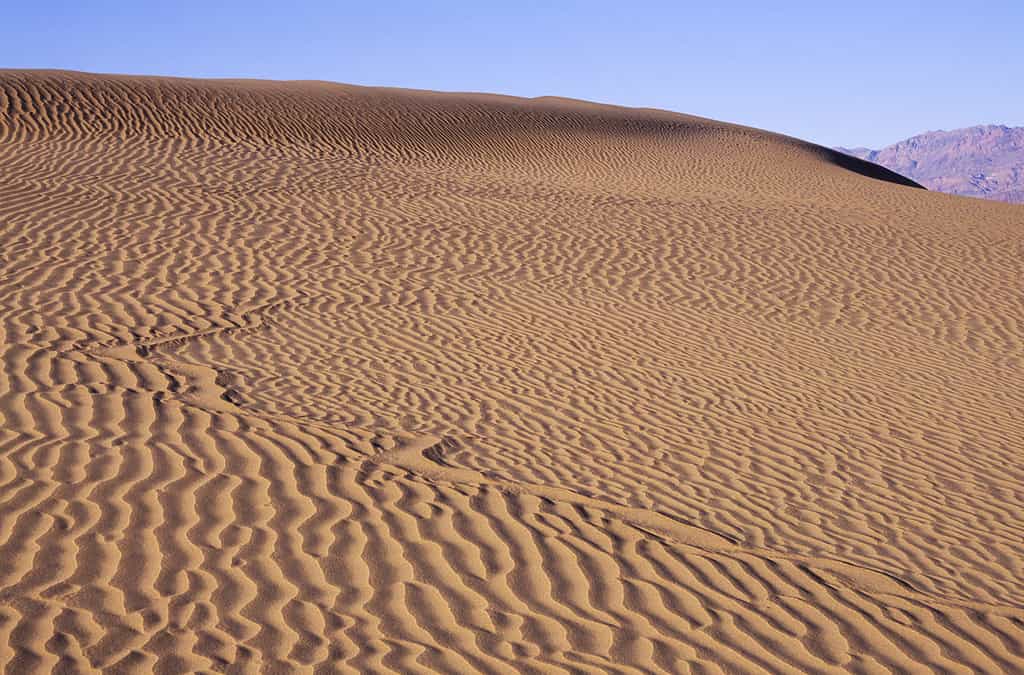
Extensive sand dunes can be found in Death Valley, California.
©Sasha Buzko/Shutterstock.com
Located near Stovepipe Wells Village, Mesquite Flat Sand Dunes in Death Valley National Park are a sight to behold. Covering 14 square miles, these ever-shifting sands form mesmerizing waves and peaks.
Permits: No permits are required for day use, but camping permits are necessary if you plan to stay overnight. You can obtain them at the Furnace Creek Visitor Center.
Visitor Restrictions: Stay on designated trails to protect fragile desert ecosystems. Watch your step, as it’s easy to disturb the delicate crust that covers the sand.
Best Time to Visit: The scorching summer temperatures make fall and winter the best times for a visit. Sunrise or sunset offers stunning photography opportunities as the dunes glow with an ethereal golden light.
2. Eureka Dunes, Eureka Valley

Eureka Dunes are the tallest in California reaching up to 700 feet in height.
©MichaelJust/iStock via Getty Images
Venture into the remote Eureka Valley within Death Valley National Park to find the towering Eureka Dunes, which can reach up to a staggering 700 feet in height.
Permits: No permits are required for day use, but if you plan to camp, get a backcountry camping permit from the park service.
Visitor Restrictions: Respect the pristine nature of this area by packing out all trash and camping at least a mile from the dunes.
Best Time to Visit: Late fall or early spring is ideal to avoid extreme heat. Camping under the star-studded desert sky is a must for a truly immersive experience.
3. Kelso Dunes, Mojave National Preserve
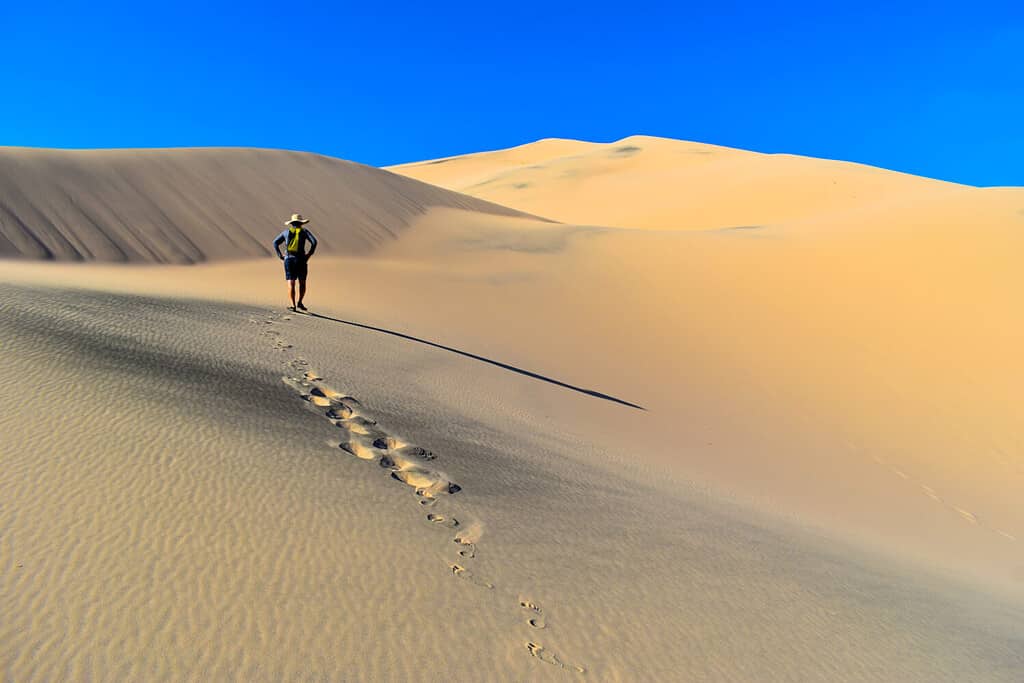
The Kelso Dunes cover 45 square miles.
©Brenda Fitz/Shutterstock.com
In the heart of the Mojave National Preserve, near Kelso Depot, you’ll find the expansive Kelso Dunes, stretching over 45 square miles.
Permits: No permits are required for day use, and camping is allowed. Obtain camping permits from the Kelso Depot Visitor Center.
Visitor Restrictions: The dunes are popular for sandboarding, so bring your own equipment or rent it locally. Keep an eye out for unique Mojave Desert flora and fauna.
Best Time to Visit: Spring or fall offers comfortable weather for exploration and sandboarding adventures.
4. Oceano Dunes State Vehicular Recreation Area

Oceano Dunes State Vehicular Recreation Area has 5.5 miles of accessible dunes along the coast.
©Ken Figlioli / Flickr – License
Located on the Central Coast, near Pismo Beach, the Oceano Dunes State Vehicular Recreation Area offers 5.5 miles of accessible dunes along the coast.
Permits: A permit is required to drive your own vehicle on the sand. You can obtain it at the entrance.
Visitor Restrictions: Be aware of high tides, as the area can become submerged. Respect wildlife and stay within designated riding areas.
Best Time to Visit: You can enjoy the dunes year-round, but consider avoiding busy summer weekends for a more tranquil experience.
5. Guadalupe-Nipomo Dunes Complex
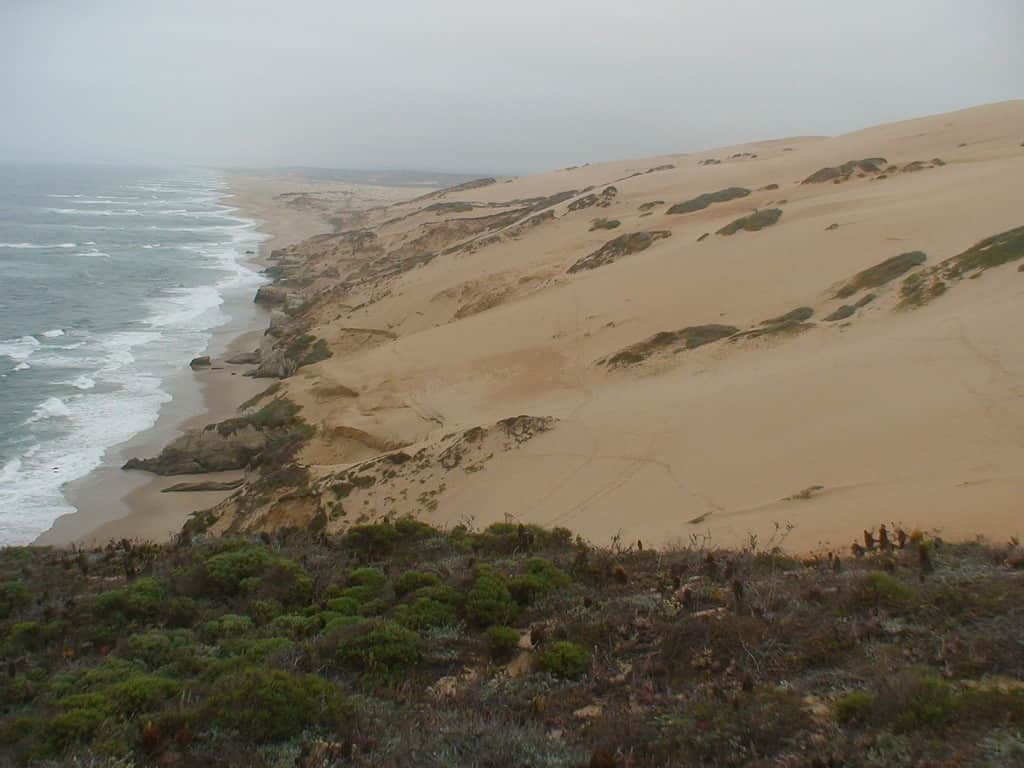
The Guadalupe-Nipomo Dunes Complex is the second-largest dune system in California.
©Kevin P. Rice, CC BY-SA 3.0, via Wikimedia Commons – License
Stretching from Guadalupe to Pismo Beach on the Central Coast, the Guadalupe-Nipomo Dunes Complex is the second-largest dune system in California, covering a vast 22,000 acres.
Permits: No permits are required for day use, but specific activities may have their own permit requirements. Check with the park service.
Visitor Restrictions: Stick to marked trails to protect the unique ecosystems and watch out for endangered species.
Best Time to Visit: Spring or fall offers mild temperatures and pleasant conditions for exploring this diverse dune landscape.
6. Kelbaker Road Sand Dunes, Mojave National Preserve
Discover the smaller, yet stunning Kelbaker Road Sand Dunes in the Mojave National Preserve, near Kelso Depot.
Permits: No specific permits are required for this area. Simply stop by and explore.
Visitor Restrictions: This spot is perfect for a quick stop and short hikes. Ensure you have water, sunscreen, and suitable footwear.
Best Time to Visit: Late fall or early spring is the best time to avoid the scorching desert heat while taking in the beauty of these dunes.
7. Dumont Dunes, Dumont Dunes Off-Highway Vehicle Area
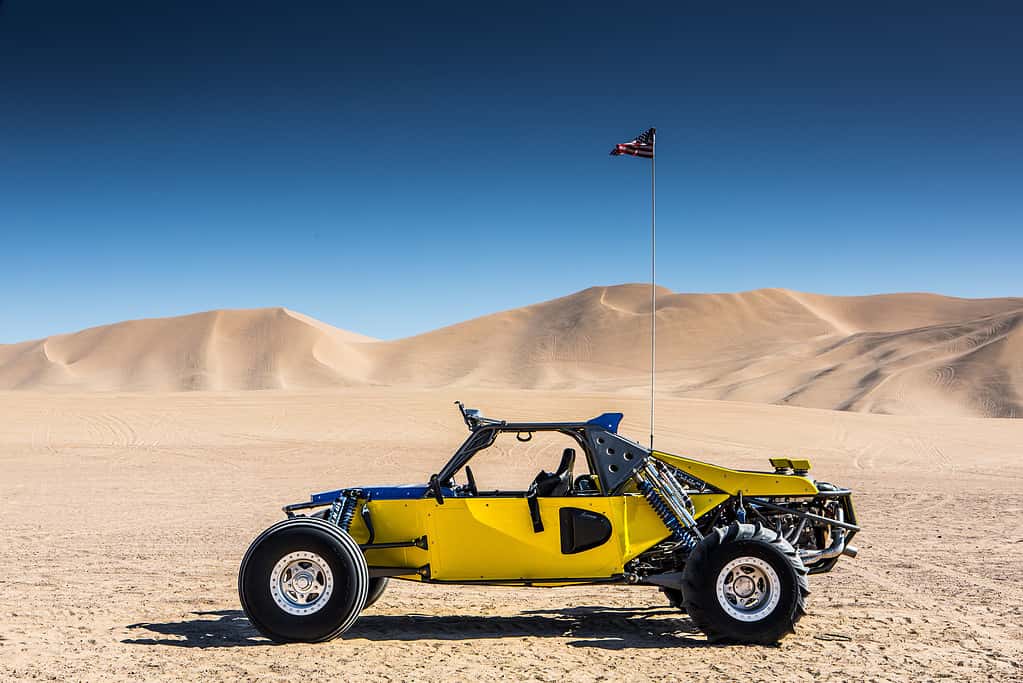
Dumont Dunes is a popular place for off-roading.
©wdalton/iStock via Getty Images
For off-road enthusiasts, Dumont Dunes near Baker in southeastern California is a playground covering 8,150 acres.
Permits: An OHV permit is required if you plan to ride off-road vehicles here.
Visitor Restrictions: Safety is paramount in this area, so always wear protective gear and follow OHV regulations.
Best Time to Visit: Winter months offer the most comfortable temperatures for off-roading adventures.
8. Algodones Dunes, Imperial Sand Dunes Recreation Area
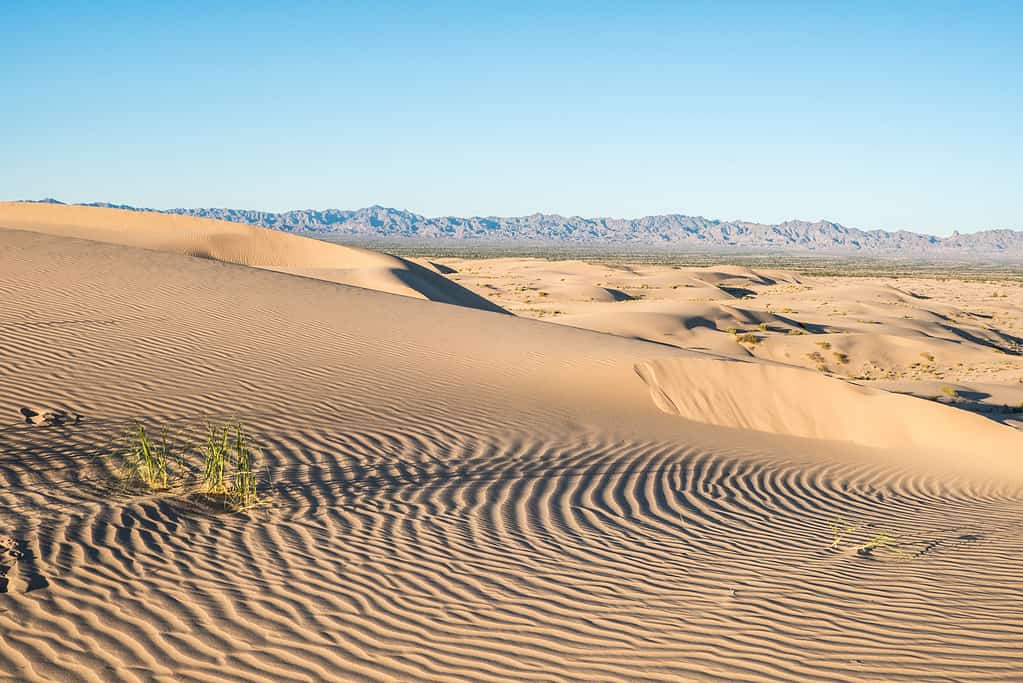
The Algodones Dunes span 118,000 acres.
©TraceRouda/iStock via Getty Images
Spanning a massive 118,000 acres in southern California, near Yuma, Arizona, the Algodones Dunes offer endless opportunities for exploration and adventure.
Permits: If you’re planning to camp, you’ll need a camping permit, available at the Glamis Visitor Center.
Visitor Restrictions: This area is popular for ATV riding, but always respect designated riding areas and safety guidelines.
Best Time to Visit: Fall and spring provide the perfect climate for desert adventures here.
The sand dunes of California are a diverse collection of natural wonders, each with its own unique charm and adventure. Whether you’re a photographer seeking the perfect shot, an outdoor enthusiast craving excitement, or a nature lover in search of serenity, these dunes have something for everyone.
When exploring these dunes, always remember to tread lightly, respecting the fragile ecosystems that call these sandy landscapes home. Follow permit requirements and visitor restrictions to ensure the preservation of these natural treasures.
Now that you’re equipped with all the information you need, it’s time to plan your epic journey to witness the unparalleled beauty of California’s sand dunes. These landscapes, from the surreal Mesquite Flat Dunes to the thrilling Oceano Dunes, are waiting to be discovered and etched into your memory.
So, pack your gear, gather your friends and family, and embark on an unforgettable adventure through the shifting sands of California’s most enchanting dunes. Start planning today and make memories that will last a lifetime!
The photo featured at the top of this post is © tapanuth/iStock via Getty Images
Thank you for reading! Have some feedback for us? Contact the AZ Animals editorial team.






